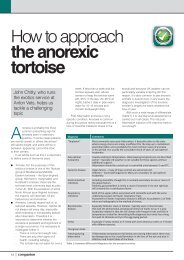Companion May 2012 - BSAVA
Companion May 2012 - BSAVA
Companion May 2012 - BSAVA
Create successful ePaper yourself
Turn your PDF publications into a flip-book with our unique Google optimized e-Paper software.
donor can be difficult. Practically type A donor<br />
blood would be an appropriate choice for AB cats<br />
as it contains low levels of anti-B antibodies to<br />
react with the recipient’s AB erythrocytes. As is<br />
clearly apparent from this discussion,<br />
administering compatible type-specific blood is<br />
mandatory in feline transfusion. See Table 1.<br />
DOnOR<br />
BLOOD<br />
GROUp<br />
RecipienT BLOOD GROUp<br />
A B AB<br />
A OK <strong>May</strong>be fatal Possible<br />
reaction<br />
B Reaction OK Reaction<br />
AB Reaction <strong>May</strong>be fatal OK<br />
Table 1: Reactions produced between donor and recipient<br />
blood types<br />
Mik antigen<br />
Recently a blood group antigen, and clinically<br />
relevant alloantibody, distinct from the AB blood<br />
group system has been discovered. Researchers<br />
have named this Mik. The absence of Mik can be<br />
associated with naturally occurring anti-Mik<br />
alloantibodies. In light of this knowledge, and given<br />
that more blood group antigens are likely to become<br />
known in the future, it is clear that the AB blood group<br />
system is simplistic. Therefore, ideally all cats should<br />
be cross-matched prior to transfusion, particularly if<br />
multiple transfusions are likely.<br />
Cross-matching<br />
Cross-matching is the gold standard laboratory test<br />
used to determine the serological compatibility<br />
between the donor and recipient red blood cells<br />
and is recommended in all cases. Practically<br />
however, cross-matching can not always be<br />
performed and its use is typically restricted to<br />
animals likely to receive more than one transfusion<br />
or before a second transfusion.<br />
From a pragmatic point of view, use of typed rather<br />
than cross-matched blood is likely to be suitable in<br />
most general practice situations. A brief guide to<br />
cross-matching, from a previous How to article<br />
(companion April 2011) is reproduced in Box 1.<br />
BOX 1: ABBreviAted slide crOss‑mAtch<br />
pROceDURe<br />
1. Collect blood into an EDTA tube from recipient and<br />
donor.<br />
2. Centrifuge tubes to settle the RBCs, remove the<br />
supernatant and transfer to a clean, labelled glass or<br />
plastic tube.<br />
3. For each donor prepare 3 slides labelled as major,<br />
minor and recipient control.<br />
4. Place 1 drop of RBCs and 2 drops of plasma on to each<br />
slide according to the following:<br />
■■ Major cross-match = donor RBCs + recipient plasma<br />
■■ Minor cross-match = recipient RBCs + donor plasma<br />
■■ Recipient control = recipient RBCs + recipient<br />
plasma<br />
5. Gently rock the slides to mix the plasma and red<br />
cells and examine for haemagglutination after<br />
1–5 minutes (presence of agglutination indicates<br />
incompatibility); recipient control agglutination will<br />
invalidate results.<br />
Despite using type-specific blood and performing<br />
a cross-match, it is still possible for transfusion<br />
reactions to occur, even when donor and recipient<br />
appear compatible, and close monitoring is vital<br />
during any transfusion. Similarly, warning clients of<br />
the possibility of transfusion reactions inspite of<br />
compatibility testing, is mandatory before any<br />
feline transfusion.<br />
Feline blood typing<br />
The principle of all veterinary blood typing methods is<br />
a visible haemagglutination reaction between patient<br />
RBC surface antigens and known reagent monoclonal<br />
or polyclonal antisera. There are several different<br />
typing kits available.<br />
Feline donors and recipients must always be<br />
blood-typed due to the naturally occurring antibodies<br />
and this can be achieved using simple in-house test<br />
kits (for example Alvedia Quick Test A+B) which will<br />
type for A, B and AB blood types (Figure 2). It is<br />
worth noting that profound autoagglutination, as might<br />
be seen with IMHA, will prevent blood typing by<br />
in-house methods. Furthermore when an AB result is<br />
received it should be checked by an external<br />
laboratory for confirmation.<br />
companion | 17



